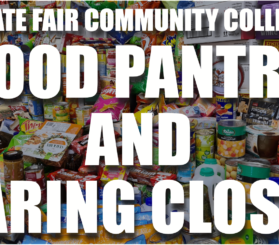Hello SFCC,
Filling out the FAFSA can seem like a daunting task to many who have not completed one yet; however, there is little need to worry if you start early. If you haven’t heard yet the FAFSA opened on Oct. 1st and the priority deadline is Feb. 3rd, but applications are accepted until April 1st. The priority deadline means that students who submitted applications by this date will have priority of funds over those who have submitted after that date. If there are enough funds for everyone that year then the priority deadline is not relevant.
The FAFSA follows a series of steps that will determine how much, if any, financial assistance you are eligible to receive. The process can take 30 minutes or it can take more than 30 days. It all depends on how much information you have available to you when you start filling it out, as well as how long it takes for you to obtain all requested documentation that wasn’t readily available to you. What I mean by this is that the FAFSA can ask for your social security number or alien identification number, tax returns, bank statements, investment records, and any tax-exempt income records.
The goal of the FAFSA is to determine how much income your family can contribute to your education expenses. This monetary number is called an EFC or Estimated Family Contribution. Once this number has been identified and verified by all required documentation then you will receive notification via email that a financial aid award has been offered to you and is available for you to accept.
SFCC’s Financial Aid Department has provided every student with an easy way to access what items need to be verified or signed via the mySFCC>Financial Aid Tab. There you will find a list of tasks that pertain to your specific FAFSA. These can either be marked with a green or red check mark. A green check mark means you have completely finished the task. A red checkmark on the other hand means….you guessed it, an unsatisfied request for information. These unsatisfied requests can sometimes be hard to understand based on their short description, so sometimes it is necessary to contact the SFCC Financial Aid Office directly and ask for specifics on how to fulfill the need for information. Before you call, I would suggest you check mysfccmo.edu to see if you can locate this information on our website. There’s a search bar that makes it super easy to locate various information.
Alright so you’ve completed the FAFSA and accepted an award. You may be asking yourself “Is this all that my FAFSA is used for?”. The answer is no, your EFC is used in conjunction with any other awards you received by most scholarships and grants as a way to determine how much financial need you have. In merit based scholarships and grants the FAFSA’s EFC is not always relevant so it is usually not asked for.
The other number that you want to pay attention to is generated by the college and is not a result of your FAFSA. This number is called the COA or cost of attendance. This number is used as a threshold for how much financial aid you can receive. If you subtract your COA by your EFC you will get the total amount of money that you can be awarded in any academic year. This can be a PELL grant from the federal government, a state grant, and/or scholarships from your school or an external donor.
Personally, my freshman FAFSA experience caused some worry for me because I didn’t pay attention to any FAFSA information in high school. I didn’t pay attention since my plan was to join the job market and fight my way up the corporate ladders. This plan is great if you have thick skin and can take the heat from your superiors. I on the other hand had too big of an ego at the time and wouldn’t subject myself to constantly seeking the approval of my superiors. These conditions led me to the best decision I have ever made—going back to school. Doing that meant I needed a way to pay for school without the luxury of scholarships or family contributions in light of being out for two years.
I attended one of SFCC’s orientation sessions which allowed me to grasp a better understanding of what information the FAFSA required. After doing this I was able to start the process and get all of the applicable tax information transferred directly from the IRS’s systems to the FAFSA application. Once I did this and submitted my application I was one of the 25 percent of students that got selected for documentation verification. Verifying these documents meant that I had to get the originals and copy them so I could turn them in to the financial aid office to verify. This can extend the award process and ultimately decrease your chances of funding if you applied after the priority deadline.
When I chose to go back to school it was January of 2019, so I had less than a month to complete the process by the priority deadline. In ideal conditions this shouldn’t have been a problem, but since I was a non-traditional student who was subjected to the verification of documentation process I was unable to complete it before the priority date. This caused a lot of worry since I needed to take two summer courses which would cost upwards of $1,500.00 USD. Fortunately, there has been an excess of funds in the Department of Education’s Federal PELL Grant Fund, which in turn allowed me to receive full federal funding for the summer of 2019. Excess funding in the PELL Grant program should not be relied on as a justification for delaying your FAFSA application. These excess funds are only because the amount of college freshman’s have steadily decreased over recent years, but it is expected to make a comeback.
Thank you for listening,
Robert Johnson
Written by Robert Johnson.
About the Author
Hi, I’m Robert! I am a sophomore at SFCC where I have been working the past two semesters as one of Student Success and Retention’s Work-Study Students. I am a pre-engineering student here at SFCC, and I plan to transfer to Missouri Science and Technology in the fall of 2021 in pursuit of my bachelor’s degree in Nuclear Engineering. I look forward to sharing with you some of the topics that I think are relevant to student success and community involvement.
SUBMIT A BLOG TO SFCC
Would you like to publish a blog to State Fair Community College? We’re now accepting submissions from students, staff, and faculty. Email your blog submission to Megan Spencer at mspencer8@sfccmo.edu


